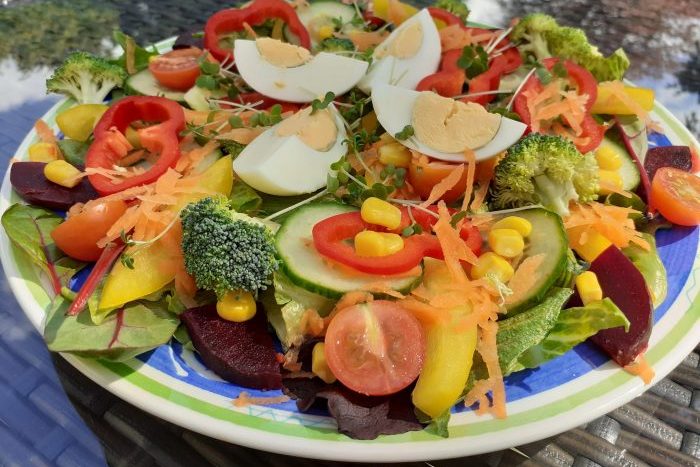This colourful salad is a feast for the eyes as well as your tummy and is packed with goodness from lots of healthy, nutritious vegetables. Anything goes so it’s a great way to get children to try new foods and they’ll learn basic knife skills preparing it. We’ve topped ours with boiled egg but be creative with cold meats, fish, cheese or a little of each; so many options!
Skills Check
Follow a recipe; follow food safety & hygiene rules; tidy away; chop using bridge/claw knife technique safely; use a vegetable peeler and box grater safely; garnish
Equipment
Chopping board, sharp knife, vegetable peeler.
Allergens (Please note the allergens listed are indicative only. Allergens vary depending on brand; check the labels on the products you use)
Mustard | Eggs | Sulphites
Ingredients (serves 1 adult or 2 children):
- 1 hard-boiled egg, shell removed
- 2 tbsp of sweetcorn
- A selection of any mixed salad leaves; iceberg lettuce, rocket, spinach
- 6 slices of cucumber
- 5 cherry tomatoes, halved or 1 salad tomato sliced
- 1 small carrot
- Half a cooked beetroot, sliced
- Half a small yellow or red pepper, sliced or diced
- A few broccoli florets broken into smaller pieces
- Some cress to garnish
Optional extras or substitutes – green pepper, celery, tuna, grated cheese, cold sliced meats, radishes, avocado
Method
- Peel and grate the carrot.
- Prepare the rest of the vegetables you are using.
- Arrange your salad leaves on a plate as a base and then attractively layer up your salad.
- Cut the hard-boiled egg into quarters and then place them on top of your salad.
- If using, sprinkle cress over the top to garnish.
So thinking about Rainbow Salad...

Vegetables are so good for us! Low in fat, sugar and calories and high in vitamins and minerals.
Nutritional Information
| Energy | 935kJ/223kcal | 11% | |
| Low | Fat | 7.3g | 10% |
| Low | Saturates | 2.0g | 10% |
| Low | Sugars | 16.0g | 18% |
| Low | Salt | 0.38g | 6% |
per 446g serving
% of an adult's reference intake
Typical values per 100g: Energy 210kJ / 50kcal
Notes
A traffic light system is used on nutrition labels to make it easier to see which foods and drinks are lower in calories, fat, sugar and salt. Try and choose more ‘greens’ and ‘ambers’ and fewer ‘reds’, and stick to smaller portions of ‘reds’.
Just because a recipe or a food has a red traffic light doesn’t mean you shouldn’t eat it. Understanding why a food or recipe might have a red light can be helpful. For example oily fish is high in total fat and so any recipe containing oily fish is likely to be ‘red’ for fat. But it is recommended that we eat oily fish at least once a week because the type of fat it contains is beneficial for our health.
% Reference Intakes are also shown. Reference Intakes are guidelines about the approximate amount of particular nutrients and energy required for a healthy diet (based on an average-sized woman doing an average amount of physical activity). Most children will require less than these Reference Intakes. The contribution of one serving of a food or drink to the Reference Intake for each nutrient is expressed as a percentage.




